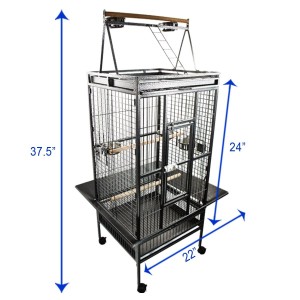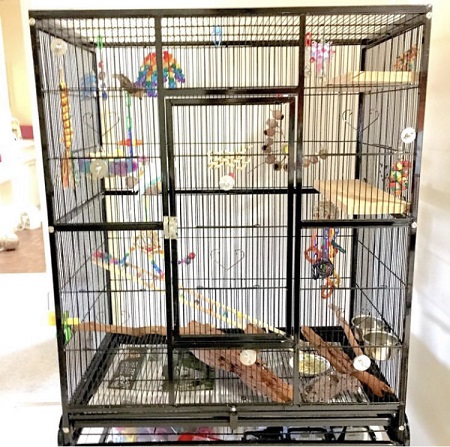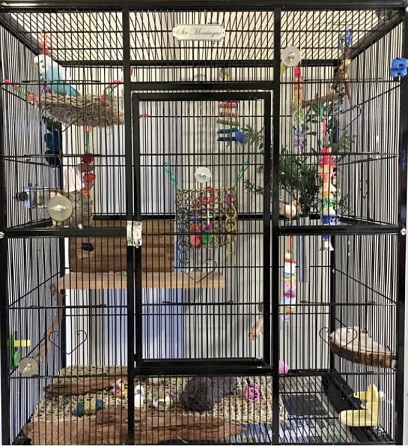Are you in search of an ideal African grey parrot cage?
I’ve got good news and bad news…
First, the bad news:
I think you’d agree with me when I say:
Finding an ideal African grey parrot cage and knowing the tips and tricks of its housing and maintenance is SO DIFFICULT.
Or is it?
Well, it turns out, that you can radically increase your success rate in getting that done.
…here’re how!
Now that good news:
So, in this post, I will show you a few simple steps to follow…and exactly how you can easily implement them.
Why Is It Important To Know This About An African Grey Parrot Cage?
African grey parrot cage and housing are the bedrock that makes your home a pet-friendly environment for your parrot. Cautiously, you must make informed decisions when choosing your parrot’s cage and housing. Notably, cage size, location, air purification, and lightening are hugely important to provide the finest housing environment for your parrot.
Herein, we have elicited the most suitable African grey parrot’s cage and housing guide. Optimistically, this guide enables you to make an informed decision when buying your parrot’s cage.
Cage Location
Often, most African grey pet parents do not prioritize the importance of their parent’s cage location. Interestingly, it’s equally important as choosing the cage size for your parrot.
Where is the Best Place to Put a Parrot Cage?
Besides informedly deciding the ideal cage for your African grey parrot. Equally important is to know where is the best place to put your parrot’s cage.
Naturally, the African grey is a highly fearful and timid bird. So, it is favorable to situate the cage higher where your parrot feels secure and comfortable.
Usually, vines and ropes, perches, and tree branches hanging from the ceiling are ideal elevations for African greys. Moreover, grey parrots are innately comfortable at elevated positions where they can relax while mimicking human speech.
However, do not situate the cage where it blocks a passage or where a lot of sunlight enters your home. Although your grey parrot needs to be heard and noticed, but extreme traffic is also not ideal.
African Grey Parrot Cage Security and Safety.
Predominantly, African grey parrots are very peaceful birds that demonstrate elegance when feeling secure and safe. In essence, they subtly scan their environment because their enthusiasm hugely relies on their security and safety. Advisably, ensure you always caution your parrot about your intentions before stroking or handling it.
Consequently, this makes them more flexible and receptive to your commands. Interestingly, African grey parrots are welcoming to surprises.
Importantly, avoid situating the cage closer to the door of the main entrance of the house. No one enjoys being disturbed, and African grey parrots are not an exception to that.
So, to guarantee your parrot’s privacy, situate the cage where only family members have access and where there is less traffic. Given that fact, your parrot may enjoy extended moments of comfort, security, and safety, which activates their innate enthusiasm.
Exemplary Cage Size for an African Grey Parrot
What size cage do you need for an African grey parrot?
Ideally, the size for a grey parrot’s cage is 2 feet deep by 3 feet wide by 4 feet high. That is; 61 x 91 x 122 cm. Moreover, it is ideal to have a big tray at the bottom. Notably, a cage with hung playable stuff and toys at the top is better than an unequipped and boring one.
In addition, All About Parrots recommends buying a square cage for your African grey than a round one. Demonstratively, it will help your parrot to develop its climbing habits to stay calm and happy.
As an elite African grey breeder with over 25 years of experience. I would personally recommend you buy a wider and deeper cage. Consequently, a wilder cage obviously provides your African grey parrot more playing space.

Cage Lightening and Air Purification
In further reference to All About Parrots, birds, and parrots have tetra-chromic vision (4 color light vision including ultraviolet). Given that fact, your parrot’s cage must have a full-color light bulb. However, a regular household monochromatic light bulb/incandescent bulb is not ideal due to inadequate lightening.
On the subject of air purification, African grey parrots are highly responsive. So, ensure your parrot’s cage has an air purifier to supply clean air. Importantly, notice that the air conditioner’s dust particles may not be healthy for your parrot.
In addition, ensure you regularly clean your parrot’s cage.
Overall, ensure that you have a hygienically clean and healthy environment for your African grey parrot. This guarantees a healthy and happy avian pet experience for you and your family.
Some Interesting Questions on African Grey Cage & Housing
What Do African Grey Parrots Need in Their Cage?
First of all, your African grey parrot’s cage should be clean, secure, durable, and fabricated with non-toxic substances. Notably, your cage’s perches ought to be of different textures, heights, and weights. Advisably, a solid perch may help to keep your parrot’s toenails tidy. Warningly, never put perches over water or food to avoid pollution.

Your Security Matters! Pet Scams, How to Avoid Them When Buying an African Grey Parrot
How Do You Keep a Parrot Happy in a Cage?
Literally, keeping your parrot occupied and happy in a cage doesn’t have to be complicated. Wonder how that works, well, try the following:
- Give them a lot of exercise.
- Frequently rotate their toys.
- Curate a parrot playlist to entertain your parrot when you’re away.
- Serve them an assorted diet.
- Spend playful times together.
How Long Should African Greys Be Out of Cage?
Recommendedly, African grey parrots need approximately 2-3 hours of out-of-cage time, exercise, and playtime every day. In essence, this helps them build muscle strength and prevent obesity. Moreover, they need this playtime with their owners involving puzzles, games, and training lessons, which is good for their enrichment.
How Do You Cover an African Grey Parrot Cage at Night?
As elite breeders, we’ve experimented on the topic of covering a parrot’s cage at night. Notably, what we observed is that there isn’t any one-size-fits-all rule. For instance, some parrots feel safe when their cage is covered at night, which makes it serene and private. Conversely, others feel neglected and unsafe when their cage is covered at night. So, we suggest you experiment with it yourself with your parrot and your observation would enable you to make an informed decision.
What Time Should I Put My Parrot to Bed?
Generally, avian pets commonly put themselves to bed by 9 p.m. and they sleep for about 12 hours. Usually, they’d hop into the cage and hang out in there until their owner cuddles them to sleep. Occasionally, they’d like to stay up late in the living room with the rest of the family.
Where Do You Put Water in an African Grey Parrot Cage?
Supposedly, the water bowl must be readily reachable from perches inside the cage. Also, ensure the water bowl is not placed where it can be contaminated by feces or urine. Importantly, make sure you regularly check the water bowl and refill it with fresh water.

How Often Do You Change the Water in an African Grey Parrot Cage?
Changing the water in a parrot’s cage should be taken very seriously because if neglected, it could easily become contaminated. On average, you should change the water in your parrot’s cage as often as every 6-8 hours.
Hygiene and Cleaning
What Can I Put in the Bottom of My African Grey Parrot's Cage?
Ensure you line the bottom of your African grey parrot’s cage with replaceable paper towels or newspapers that are easy to use and clean. Also, you may use a cage liner which provides a proper layer of antimicrobial protection. Additionally, ensure you consistently keep your African grey parrot cage clean and hygienic.

How Do I keep My Parrot Cage Clean?
Regularly, pull the water bowl out and clean it thoroughly with non-toxic disinfectant soap and clean water. You may also need to use something like a nylon bristle brush to scrub out all the sticky particles. Use a duster or nylon bristle brush to wipe down any dust in between the bars of the cage at least once a week. Importantly, to ensure the cage’s long-term cleanliness, constantly replacing the perches.
How Do You Clean Bird Poop from the Inside?
Using a warm, wet cloth, take a few passes at the spot to get the worst of the poop out. Also, use pinching, and pulling motions with the wet cloth to coax the droppings out of the cage.
Can I Clean Bird Cage with Alcohol?
Actually, rubbing alcohol is relatively secure to use in cleaning a bird cage. However, ensure your bird doesn’t return to the cage room until the smell is totally dissipated.
Those are the Tips and Tricks of an African Grey Parrot Cage.
Thanks for reading and we hope you found this useful.
You may want to visit our Available Parrot Page to view our available parrots. In addition, we have a benevolent African Grey Community you would find pleasure engaging with. It’s all about African grey owners being proud African grey parrot Owners like they really should. Therein, we share amazing tips with each other, celebrating holidays, and playing games.
Once more, Thanks for Reading!!!
You May Also Like -
African Grey Parrot for Sale Near Me
African Grey Parrot For Sale – Secrets To Know Before Buying
African Grey Parrots, Hidden Secrets You Need To Know
African Grey Parrot Diet & Nutrition
Toxic Foods For Parrots -Top 7 To Never Feed Your African Grey
Avoid Parrot Mills When Buying An African Grey
How To Avoid Pet Scam When Adopting An African Grey Parrot
Lifespan of African Grey Parrot. How Long Do African Greys Live?



